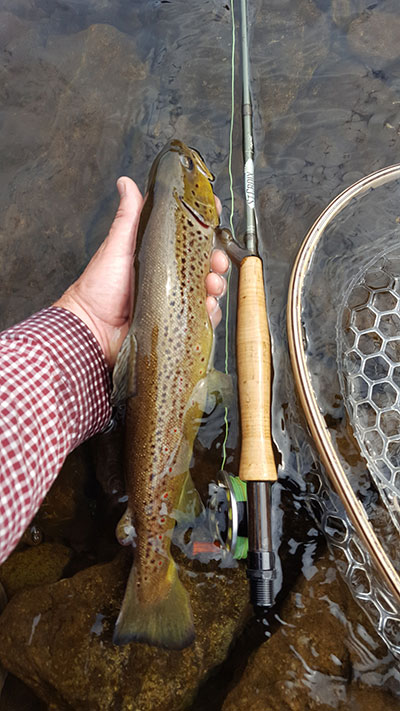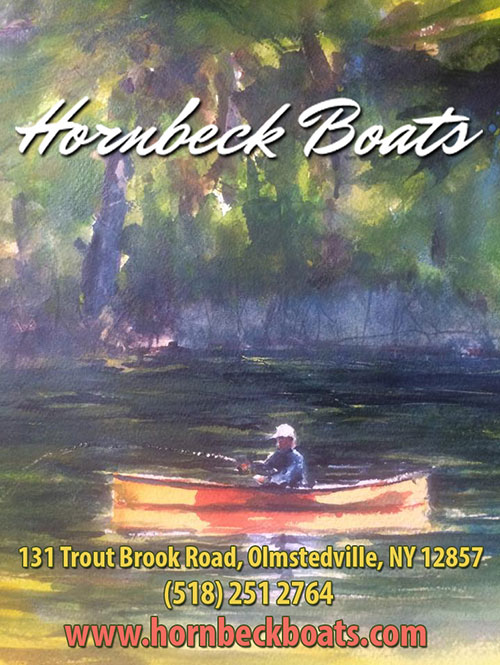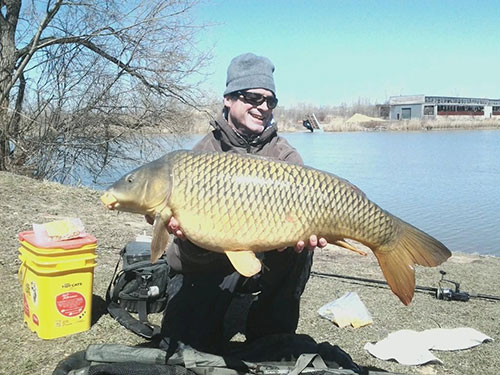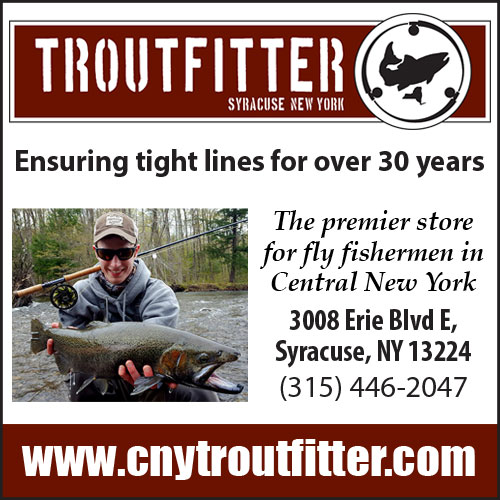
Reading Water: Back to Basics
There are a multitude of fishable features contained within any given trout stream. Rivers and streams come in various sizes, depths, flows, aggressiveness etc. but all will contain certain traditional cliché fish holding areas. How you choose to attack them will often determine your overall success or failure. First off, identifying where the fish will be positioned within any given scenario is crucial, and more importantly why these fish are staged where they are is even more important in the overall big picture.
Let’s take a look at some of the more common ones and how to effectively evaluate and fish each situation.
The Pocket
Fishing aggressive flowing pockets and plunge pools are perhaps my favorite type of trout habitat. Freestone rivers like the infamous West Branch of the AuSable with steep descent grades are quite conducive of having lots of pocket water. There are many options to fish these pockets but I personally find tight-line or Czech style nymphing with a tandem fly set-up to be my most productive. For one, the flow is usually quite heavy making an excellent eye shield for you to sneak as close to the pocket as possible without worry of spooking the fish. Two, these aggressive flows associated with said pocket water are bringing food rapidly past the trout holding within, forcing them to make an immediate decision to eat or not to eat before that bit of sustenance (AKA your fly) is long gone, because of this the takes are usually very aggressive and easily deciphered above water. Also, as summer drags on and water begins to warm the plunge pools will also harbor the most oxygenated water therefore concentrating and containing the most active trout in the river.
The Backeddy
Probably the most typical and well- known holding location for a trout. A steady flow broken up by some type of obstruction in the stream, whether it be a boulder, a log, really anything that breaks the current. Trout are lazy and will take advantage of a current break that still delivers the benefit of a full stream food influx without the exertion of energy to remain out in a strong flow. It’s really the best of both worlds for them. It’s like someone delivering you breakfast in bed. Why wouldn’t you stay there? As currents divert and come around each side of the break fish will stage on the edges. Think of this as a “V” with the bottom of the V being the current break, picture it in your mind and watch how the currents react. The stronger the flow and the larger the diversion, the larger the V will be. Fish each edge of this V as fish will be staged off both sides. The super soft water directly behind the obstruction will hold few fish, but the edges and as you get out a few feet will hold numerous.
The push, as I like to call it, is a sneaky little spot located directly opposite the backeddy. This is the upstream side “cushion” of water if you will that bounces back off an obstruction creating a spot soft enough for a trout to take up residence. This can be a great location to swing streamers or soft hackle wet flies across in a fanning motion starting upstream and getting ever so closer to the diversion with each swing. Never pass up a few drifts in the “push.”
The Pool
Large pools might be the most popular locations on any given river system to fish and very possibly my least favorite trout holding area to target. They see the most anglers by far and contain the most educated trout. Dry flies prevail in pools, a nice presentation of the proper fly can surely elicit some takes as can some deep nymph presentions under an indicator. Definitely not a spot to pass up, but I personally don’t devote a ton of attention to large pools. On a side note, large pools can also contain some of the largest trout in the stream as well, to target these specific fish try throwing overly large streamers or mice at night when the traffic of fishermen has long since disappeared and the big guys emerge from deep structure under the cover of darkness to hunt.
The Run
Another solid trout holding location, a stretch of moving unbroken water that has the depth where trout feel comfortable remaining out in the open. The larger the run the higher the number of trout staged in it will be. The thing with a typical run you must remember is that the almost always the water near the bottom will be moving slightly slower than the water on in the top section of the water column. Hence, causing almost all fish to be lying within a few inches of bottom to conserve energy while the conveyor belt of food flows above them and they zip up off bottom to take whatever offering is overhead. When dealing with a run it can be very important to start your drift much farther upstream than normal. Think about where the fish should be and how long it will take your presentation to get down to their level. The faster and deeper the run the longer the cast you need to make upstream will be prior to starting your dead drift and actually fishing it. These fish are always looking up and sometimes the water can be somewhat smooth so be extremely careful approaching a run, especially on a sunny day. Don’t cast any shadows upon it and stay low as you make your casts and many fish can be caught from a single spot.
The Undercut Bank
The big fish haunt. Chances are the largest fish in the river will be in this spot. It offers shade, an insane amount of cover and protection from predators, and an absolutely fabulous ambush point for a large predatory trout. Usually located on a bend in the river, it will be deeper water as well with a non stop flow of food directly into the face of big trout. Big fish like to make their energy exertion worthwhile. This equates to big streamers. Start upstream and drift them deep and under the bank and once in the zone make that fly scramble to escape as if it knows it is great danger of being eaten. Erratic fast strips will often trigger a big trout to not allow that fly to leave his domain. Watch for followers coming out chasing your fly, if this happens hold off casting directly back in. Wait a little while and come back later. Drift your streamer in just a little deeper and repeat. You now know he’s there. Catch him.
The Tailout
On the very end of a pool or run right before the water changes into some other style of current there will usually be a few fish. Especially in periods of low light fish will often get into a feeding mode and stage up in this location. It can be a great spot to concentrate fish during a hatch as well. Approach from downstream and watch carefully for rising fish and make spot on accurate casts. Deeper tailouts can also be nymphed with excellent success.
The next time you’re on the stream remember these 7 basic “go to” Trout holding spots and fish them all. Best of luck.
Check out Jerrod and some really great outdoor adventures at www.downwindoutdoors.com
Smallmouth On the Fly

Enter the warm water brown trout. The Smallie. The Brownie. The Bronzeback. Whatever you choose to call them smallmouth bass are pound for pound one of the best fighters in all of freshwater and so prevalent almost anywhere. Whether it’s a local lake, river or stream. If it is a warm water fishery it is bound to have a population of smallmouth lurking within it.
Typically, anglers target smallies with conventional tackle. Throwing cranks, twitching top water and snapping jigs and the like, but they will succumb to fly gear just as easily.
Most any flyrod in the 4 to 7 weight range will suffice, however I personally would stick with the higher end of things here and go 6 or 7 if you have the option. For one it will allow you to cast sinking lines and larger flies more easily and two, will have a bit more backbone for fighting a healthy size Bronzeback.
Fly selection really isn’t all that critical. Given the aggressive nature of a smallmouth you probably won’t experience downright refusals like fishing drys for pressured trout if you don’t have the proper fly tied on.
If you want them to smash big deer hair bass bugs, have at it. Feeling like practicing your tightline Nymphing techniques? Throw on a big stone or a hellgramite pattern and dead drift away. Feeling like stripping streamers? Small clousers, wooly buggers, and any other baitfish type streamer will work. It’s really up to you and the style you want to fish. The bottomline is that smallmouth can be caught using a plethora of flyfishing methods.
Smallmouth fisheries are very much different than the highly secretive and taboo locations of hotspot trout water, which even a close mention will give a diehard trout guy anxiety. Most anglers are willing to share places they’ve got into good smallmouth action.
One of my local favorites is the Schoharie Creek, a large but fairly non agrressive stream that can be fished almost anywhere along it. There are endless access points which a streamside drive will reveal. It is easily wadeable and most any fly tactic will take fish. The water this time of year is warm and the fish’s metabolisms are running high as well, so keep your fly moving, an erratic stop and go strip whether fishing buggers on a sink tip or big poppers or even mice on the surface will elicit some vicious attacks. Top water action can be especially good in the early morning and late evening. Look for the darker, deeper runs with moving water to hold the larger fish. Bass in a stream are exactly like trout in a sense that they will stage and position themselves in a place where they will have an influx of food coming by them while exerting a minimal amount of energy. So scrap the waders for a pair of shorts, grab your rod and a handful of big ugly flies and target the usual haunts you would for trout and hold on.
Fly Fishing for Carp
By Greg Osenko – Capital District Fly Fishers
Targeting carp on the fly rod has become increasingly popular in recent years as they offer a new challenge for us to target. Carp can grow to large sizes and live in many of our local rivers, lakes, and ponds making them accessible to almost everyone. They are very tolerant of poor water conditions and can be found in muddy ponds to clear lakes.
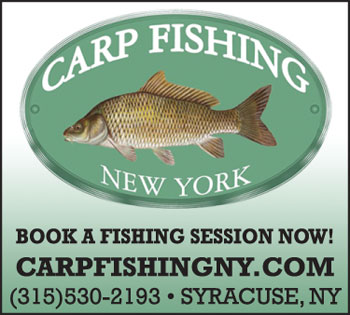
Flies to use for Carp
Carp are omnivores and will eat both plant and animal matter so you can cast a wide variety of flies. It’s important to know what food source is in the water so that you can imitate it with your fly. Carp seem to have an affinity for marabou, rabbit fur, and rubber legs – many carp patterns use these materials. Most carp flies are situated to fish off the bottom either by using lead or bead chain eyes. You will have to experiment with what really works for each condition and don’t forget to have some dry flies and/or emerger patterns in your box.
 Here are a few staple flies
Here are a few staple flies
– Wooly Bugger
– Caddis Emerger
– Carp Candy
– Damselfly Nymph
– San Juan Worm
– Swimming Clouser Nymph
– Crawfish patterns
– The Usual or Elk Hair Caddis

GREAT NEWS for Upstate NY fly fishing fans!! Charlie Warfield will now be providing monthly NATIONAL fly fishing coverage each month in all The Angler/Coastal Angler publications. His coverage is just starting and will be expanded. Jerrod Vila will now be The Angler Magazine of Upstate NY’s fly -fishing editor, and you readers are in for a treat. Jerrod has been providing a steady stream of impressive photos and informative content this year, and his local stream trophy catches via the fly are becoming legendary in my eyes. I am very proud to be adding Jerrod and am equally pleased that Charlie’s content will be covered throughout the nation. Jerrod’s fishing range will extend our local range east, since The Battenkill is among JVILA’s favorite trophy haunts, though he is an avid West Canada Creek Angler also.
Fishing Large Streamer for Big Trout
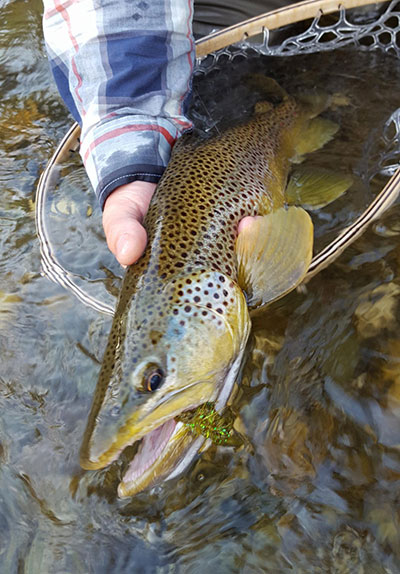
By Jerrod Vila
What does one think when they hear the word “fly-fishing”? I would be willing to bet most would picture a gorgeous tight loop, flawlessly unrolling, and delicately delivering a tiny dry fly to the surface of the water with little to no disturbance, drifting downstream at the precise speed of the current, hopefully to be slurped up by an eager trout from down below, but there are a multitude of other methods to be taken of advantage by the fly fisherman.
One of my favorites is streamers, not your typical classic old school Grey Ghost or Mickey Finn style (they certainly have their place as well) but big streamers. Ungodly creations of fur and feathers that more closely resemble a dust bunny that has been hiding underneath the couch for years. This technique is not artful, and by no means delicate, but it produces trout. Big nasty trout.
Throwing large streamers for big trout is really a mindset kind of thing. You must mentally prepare yourself for not catching a ton of fish and no matter what is happening to stick with it, 500 lackluster empty casts later without even a follow. Stick with it. It will happen and when it does it will make every previous cast oh so worth it. The sheer viciousness that a large trout savagely hits a big streamer with is unreal. Once you hook your first big guy, well it’s all over from there on out. It becomes an addiction that no other method of fly-fishing really seems to satisfy.
One really needs to devote an entire day on the water, or possibly even longer, to doing this and only doing this. It is not the type of thing where you open your fly box and say to yourself, “Yeah, this guy looks good” pick a 6-inch streamer out and give it a few casts here and there or work a small section of stream and change up after a short period of time with no action. It’s difficult to get into the proper mindset while fishing with buddies who are using normal techniques. They will be catching normal size trout with frequency and that will ruin your confidence and make you want to join in the crowd and not be the only guy to get skunked and succumb to healthy amounts of ball busting until the next outing. For this reason, I like to fish big streamers alone or with 1 other person whom is doing the exact same thing.
Now for gear, sure you can throw large streamers on a typical fast 5 weights. It’s not easy and not recommended but it’s doable. In all reality, though to efficiently be rolling this style of fishing you really want a 6 or a 7-weight rod. I am usually running these on a sink-tip or a full sinking line, depending on water depth and given current situation. Kelly Galloup’s Streamer Max Long by Airflo is really the perfect line for this style of fishing. It has 30 feet of a high density sinking line then a transition to nice intermediate running line, it really stays down in the target area while being aggressively stripped and really “shoots” surprisingly well. Also, most full sink or lines like the Streamer Max cast much better than a sink tip or a poly leader attached to the end of a floating line. Don’t expect or even try to achieve nice tight loops when fishing huge flies and sinking lines, it’s just not going to happen. Open up your loops and pretty much lob your flies on target.
I normally like to work a river upstream, not the case when fishing big streamers. I’ll work it down. I feel I can be much quieter and be stealthier when walking with the current as opposed to against it. Most fish will hit on the swing, so the area you expect the take to come in will be downstream of your location, so if you were working upstream you could have walked through this area already or at least close enough to it to have spooked a possible fish. Cast across, swing it down, take a few steps down stream, cast across, swing it down. Fanning the river using this method really puts your fly in front of many fish and effectively covers most of the river or stream.
What about the flies? I really like throwing the 4” to 6” articulated stuff around here. From Sex Dungeons, to Butt Monkeys, to Circus Peanuts. The list of crazy flies with even crazier names goes on and on. They all work, but those aforementioned 3 flies are a few of my favorites. You have to get over the notion and thoughts that your fly is too big. It’s not. It took me a long time to realize this but it’s so true. I am fairly certain 25” brown trout would attack a squirrel if given the chance so a 6” fly is nothing for a big trout to engulf.
I prefer to run a very short leader of straight tippet material. There is no need to softly land a dry fly atop the surface so there is also no need for a fine tapered leader. Depending on fly weight, current and depth I feel the fish will be will determine the leader length. Faster current and deeper water I will shorten up the leader, 2 or 3 feet is not uncommon. For most situations, I am probably starting off with a leader around 4 feet. Don’t underestimate these fish, they are big, aggressive and will break you off in a heartbeat. You are stripping one way, a big fish and the current are going the other way. Be prepared for this. Learn from my mistakes and upsize your tippet. I run 3x fluoro on 4 inch sized flies and 2x fluoro on anything larger, and if any of this is taking place at night go straight for the 1x. Night time is a whole different adventure which will have to be addressed in another article at a later date.
So get out on your stream and “Throw ‘em the Meat!!”, work the seams, the undercut banks, the log piles, anything that seems like it could harbor a large trout. Good luck.
Hungry Trout Brookies Dominate Crossroads Outdoors Brook Trout Contest
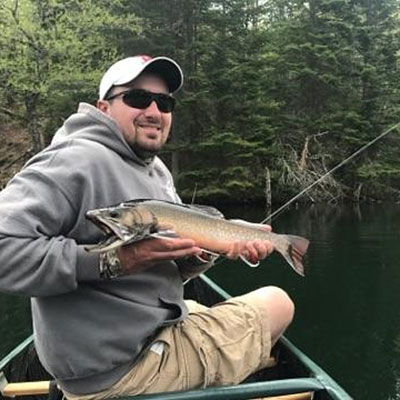
Wayne Weber of Wayne-O’s Guide Service www.wayneosguideservice.com won our May/June long Instagram contest with his incredibly impressive huge-mouthed trophy ADK brook trout pictured below. His photo yielded 183 Instagram likes and Wayne chose a collection of Lake Clear Wabblers donated to the contest by www.lakeclearwabbler.com. Wayne was guided by Hungry Trout Fly Shop guide and The Angler Magazine fly-fishing contributor Matt DeLorenzo while he scored this lifetime best trophy. Second place coincidentally with 172 Instagram likes was Evan Bottcher also a guide with The Hungry Trout Fly Shop www.hungrytrout.com.
The Hungry Trout Fly Shop obviously has a great handle on finding and catching trophy ADK brook trout via the fly. This year I have had many reports of big brookies succumbing to newly advanced fly-fishing methods which certainly can be learned through a guided trip with a professional. There are so many great fly-fishing opportunities in The Adirondacks, and mid and late summer is a great time to explore backwoods pond brook trout, especially when we start experiencing lower and warmer stream conditions. Evan or Matt are easily reached to book trips via email at info@hungrytrout.com or by phone at 518-946-2217. Nicole Trowbridge won a personally selected collection of Hillbilly Lures www.hillbillylures.com with a beautiful brookie she earned by hiking over 3 miles to a remote Catskill pond.
Special thanks go out to the Crossroads Outdoors www.crossroadsoutdoors.com for sponsoring the contest. The Crossroads Outdoors in Chestertown, NY is located right along a very productive and well stocked section of the Schroon River, with excellent public access and outstanding trout water. This year’s early wet weather should help ensure fantastic summer fishing conditions and water levels. While on the Schroon, make sure to check out Crossroads Outdoors huge ADK fishing selection with an expanding fly-fishing inventory.
Fly Tying Patterns

Matt is a full time Fly Fishing/Upland Hunting guide for the Hungry Trout Fly Shop in Wilmington, NY. He can be reached through the fly shop info@hungrytrout.com
If you’re like me, you probably carry a small army of dry flies. It’s important to be armed with whatever you might need to take advantage of the great dry fly fishing that spring and early summer can provide.
Last month I wrote about how the fly fishing market is packed full of fly patterns, and how the search for the holy grail of flies continues. Surely this hunt will continue until long after we are gone. The fly you will see in this issue is as close as I have come to the real deal. I know this fly to work through a variety of hatches when tied in neutral colors. This pattern has a few things that I look for in a good dry fly pattern. I like my flies to ride low in the water which gives the fish a good look at them and makes the imitation appear trapped. I also want them to be visible to me. There are few things more frustrating than trying to pick out a fly in the water.
The design of this pattern allows the fly to sit low in the water, but the combination of two different hackle materials flares the hackle upwards on the post and which keeps most of the hackle above water. The post itself makes the fly a little easier to pick out. One of the nice things about this design is that due to the flare of the hackle, you can easily disguise a short Hi-Vis post if you require it.
I talked at length last month about color. I’ve taken several approaches to this pattern. I like to keep a bunch of them around in neutral colors. Because this fly is an emerger or a stillborn imitation, you can get away with many different colors to imitate a variety of bugs. By carrying brown and tan I fish this fly effectively through most of the major hatches. You can also tie it on a klinkhammer hook to get a true emerger profile.
Hook: Daiichi 1110 #12-14
Thread: Veevus 16/0 Brown
Shuck: Faux Fox – Brown
Tail: Lemon Wood Duck Fibers
Abdomen: Turkey Tail
Post: Para Post Wing – White
Hackle 1: Grizzly Hackle
Hackle 2: MFC Henry’s Fork Hackle Ultra Light – Mottled Dun
Thorax: Hareline Dubbin

Now you are going to tie in the post and the hackle materials. Tie your grizzly hackle in first onto the post, then move down and tie in the Henry’s Fork hackle.
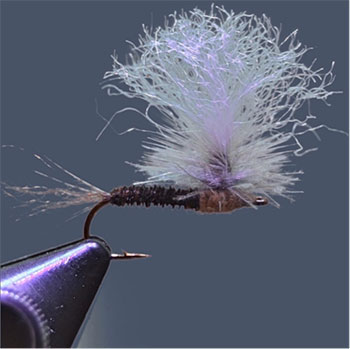
Matt is a full time Fly Fishing/Upland Hunting guide for the Hungry Trout Fly Shop in Wilmington, NY. He can be reached through the fly shop info@hungrytrout.com or by phone at (518) 946-2217.

Dr. Hendrickson
Matt is a full time Fly Fishing/Upland Hunting guide for the Hungry Trout Fly Shop in Wilmington, NY. He can be reached through the fly shop info@hungrytrout.com
Dry fly fishing is what its all about for most people, and for good reason. Few things are more exciting than seeing a trout rise to a well-presented fly and watching it sip it down. Fly Tyers understand this more than most as it is commonly argued that there is nothing better than catching a fish on a fly of your own making. Catching one on a dry fly that you made yourself, that brings it to a whole other level.
Early season however, I stick to the nymphs, fish can be caught during the first hatches of the year, sometimes in good numbers. But I find that they are not usually rising as consistently or for as long as they will later in the year, so I always stick to nymphs in all but the best of hatches. I wanted to present a fly this issue that most people don’t think about during spring. Usually we get hyper focused on fishing the first hatches of the year.
The fly fishing market is inundated with flies available to purchase and with tutorials on how to make them yourself. That is for good reason, there are a huge variety of imitations that may be effective at one time or another, or that may work from one locale to another. The holy Grail of fly tying is the one fly that works all of the time. That fly surely does not exist but there are several that come close, and the fly you will see in this issue I believe to be one of them.
Dedicated fly tyers adhere to a few guidelines when designing flies, some take it to the extreme, particularly in the Catskills, and there is nothing wrong with that. With that said, there are a few things every fly should have whether you follow the rules or not. Size, color, and shape and the benchmarks that most designers adhere to, these three things are often written about and are vital to successful design. But rules are meant to be bent. Shape should certainly always ring true when designing a mayfly. Mot mayflies adhere to the same general shape. The size and color are where you have some wiggle room when designing an all-around fly. Many mayflies fall within a certain size range and that range will vary depending on where you call home. Regarding color, there is a lot of variable here, but in a general spectrum a cream, tan, or brown will get it done. I tend to stay in the brown colors and it has never failed me.
The general mayfly patterns I tie are all built around one concept…pop. I want my flies to stand out amidst thousands of natural patterns. That doesn’t mean I tie the flashiest flies I can. It just means I like to add a little something extra. This pattern is my go to early season nymph and it possesses this quality. I also like to tie it one size larger than the naturals. This goes back to what I said about rules being bent. It has just the right combination of realism, bugginess, and flash, it stands out. When most of us are starting to hit the water, hendrickson nymphs are becoming more active and beginning their emergence. This fly gets it done for me year after year in the early season and I hope it can do the same for you. No matter how you tie it or how it comes out, enjoy the process and put it to work. Stay safe and good luck.
Hook: Daiichi 1167 #12-14
Bead: 1/8 Tungsten – Brown
Thread: Veevus 16/0 Brown
Tail: Turkey Tail Tip
Rib: UTC Brassie UltraWire – Black
Underbody: Whitlock’s SLF Pattern Blend Dubbing – Brown Stone Nymph
Abdomen: Turkey Tail
Abdominal Segment: UNI-Yarn “Kaki”
Shellback: Thin Skin – Mottled Oak
Thorax: Craft Store Ribbon – Brown
Legs: Hen Back – Natural Brown
Collar: Whitlock’s SLF Pattern Blend Dubbing – Brown Stone Nymph

Wrap the turkey tail forward to create the rear ¼ of the abdomen and tie it down tight. At the thread point, tie in a piece of UNI-Yarn and twist it into a tight rope. Wrap the rope forward three to four times and tie it off.
Create a dubbing rope and dub a body forward of the Turkey tail. This helps create a uniform body so that you don’t have build up bulk using only the Turkey tail. It also creates a small amount of flash through any gaps in the body.
Wrap the remaining Turkey tail forward and tie it off, now you can wrap the wire forward to create a durable body and minimize the Turkey tail from fraying.
Tie in a pice of thin skin first, this will become the shellback. Next you tie in a piece of trimmed and stripped craft ribbon. This is a great material to add gills, flash, or just buggy movement. Once those are tied in add some more dubbing to help with the proportion.

Tie in a few legs on each side. You can use Hungarian Partridge or any other like material. I choose to use natural Hen back for because I feel its the best match for color.
Pull the thin skin forward splitting the legs and tie it down tight. Now you fold it over towards the back as shown in the photo and lay down a couple wraps in front of the fold to encourage it to lie backwards.
Here you can choose to add a small amount of dubbing or not. I like to add a little bit of dubbing on the collar to encourage the shellback to lay flat. In this photo I show you what happens to the trimmed shellback if you just finish it with a thread head. It will work just fine this way or you can add the dubbing, careful not to add too much.
In the photo of the finished fly you can see how adding a small dubbing collar can improve the fly a great deal. If you a prone to having problems with bulk like a lot of people are, this is the step you leave out and finish the fly like the previous photo.

The Ausable River Two Fly Challenge
The Ausable River Two Fly Challenge starts at noon on Friday May 19th where anglers check-in and receive their fishing packet. Then it’s off to fish for the day. There is smooth water, boulder pockets and pools, all waiting for you to flip a fly into.
After an afternoon of fly fishing, come join us Friday evening for our Fly Tier’s Reception where you can share your day’s experiences on the river, and maybe learn new skills from talented Tiers. There will be live music as usual.

Finish your weekend Saturday Evening with a banquet complete with prizes, raffles, and back by popular demand….A Fly Casting competition! This year’s Guest Speaker is a secret so far. You may register by calling Michelle at (518-946-2255).
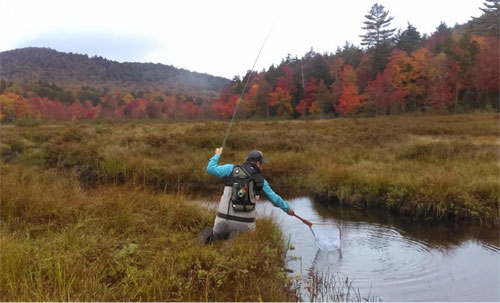
The Ausable River Region of Upstate NY
By Charlie Warfield, The Angler Magazine Fly Fishing Editor
The Adirondack State park was established in 1892 and it boasts 6 million+ acers of wild terrain and epic water. As a Native of the arid state of California, when I moved here 6 years ago I was immediately impressed by the sheer amount of water in the Adirondacks. The Adirondacks are famous for their majestic beauty and this alone is enough to keep me here despite the long cold winters. The great fishing opportunities, in the ponds, lakes and streams of the Adirondack Mountains has been the subject of many volumes. But none are as storied as The Ausable River.
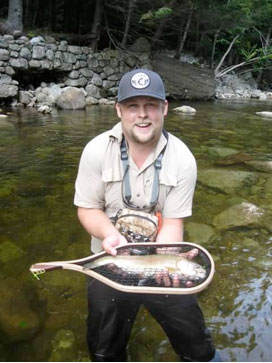
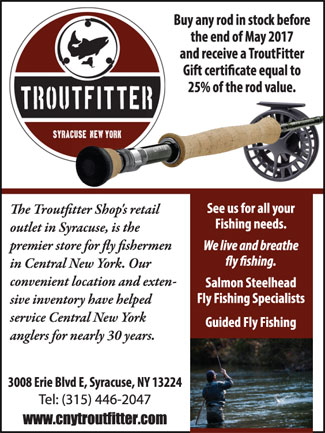
The Hungry Trout Resort is a beautiful destination with its well stocked fly shop and plenty of knowledge from its local guides. The resort also has great package deals that include lodging, dinner at their restaurant, and a day’s access to their “Dream Mile” which is a catch and release fly fishing only section of the river with a daily rod limit of 8 (call 1-800-766-9137 for information and booking) The Ausable has dependable hatches from April through October, and for the streamer junkies there are plenty of large territorial fish. I particularly like to fish the aggravatingly small (think size 24-30) Trico hatch in late summer with its ravenous and seemingly undiscriminating fish. Stone flies, terrestrials, and other large patterns like Stimulators or Ausable bombers are a good bet if there isn’t an obvious hatch and during mid-day fishing.
I love living near this area so I can visit frequently but for those of you further away I would definitely suggest that you take the time and make the trip to this beautiful river. The Adirondack Spruce Lodge in Wilmington, NY is a quaint, friendly resort who expressed interest in accommodating fishermen to The Angler Magazine by offering fisherman’s packages, call 518-946-8232 and use promo code: Angler mag or go to www.adirondacksprucelodge.com for room availability. The High Peaks region is also a great family destination with plenty of attractions and activities for everyone to enjoy. Catching beautiful trout among the breathtaking High Peaks is breathtaking. Experiencing it yourself is priceless and just a short ADK drive.
Fly Tying Struggles
By Mark Usyk
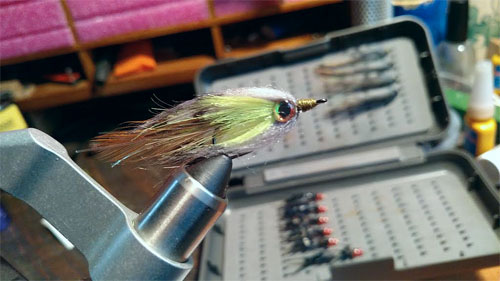
I’m tying for some peace of mind on a cold day, but I’ve got a couple planned trips coming up to great lakes tributaries that I need to be filling a box for, so I’m at least tying patterns that will get me ahead of the game on that front. Funny thing the way that works though. No matter how many I tie, the day before I’ll decide I don’t have enough and go into fly tying panic. Staying up late the night before is in my near future, it’s almost a guarantee. And what’s even funnier than that is that I’ll tie in preparation, then tie in panic, and then when I’m actually on a river for a couple days, I’ll only use a couple of them if the box has thirty in it. It’s a viscous cycle that repeats itself all the time.

You think you just want to tie Woolly Buggers so you buy a cheap vice, a package of hooks, some marabou and chenille, and a spool of thread. Then before you know it you’ve rebuilt a room in the house to hold a tying desk, a wall of drawers full of materials ranging from hackle capes from every known chicken and game bird known to modern ornithology, rabbit pelts, buck tails in more colors than the kids breakfast cereal with all the marshmallows, squares of elk hair in twelve different shades, and more tinsel that the past five years Christmas trees all put together. As a matter of fact, you actually kept some of the tinsel off this past year’s tree because it was a different thickness than any you already had, and you can’t stand to see possible fly tying materials go to waste. Some people might look at you as a type of hoarder, but you have plans for everything you stuff in a drawer or plastic storage bin, even if you don’t know exactly what that plan is just yet.
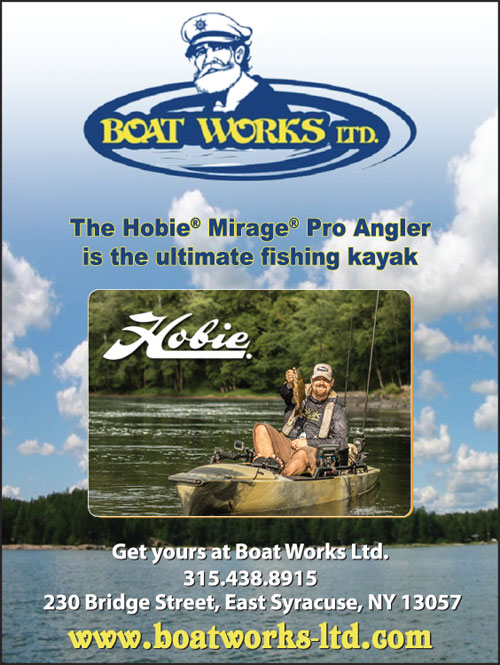
Fly tying relates to fly fishing in two ways. In one, the flies are what you cast to catch the fish. That’s the simple one. The other is the fanaticism that’s connected to both. It takes over just as the fishing itself does. I’m in Upstate NY, but last week I tied up a couple squid patterns that you’d use in salt water, the idea that I could fool my brain into feeling like I was in a warmer, sunnier, tropical environment. All I did was drink rum because of it instead. I don’t know what’s more alarming in this instance. The fact that I tied up a squid pattern in the frozen north, or the fact that I had the right materials to pull it off. The struggle is real.

